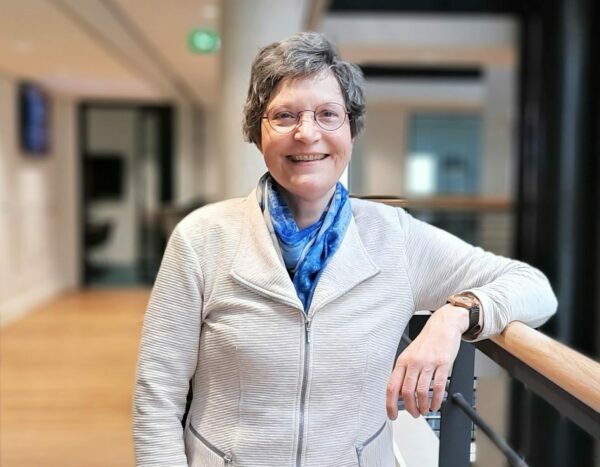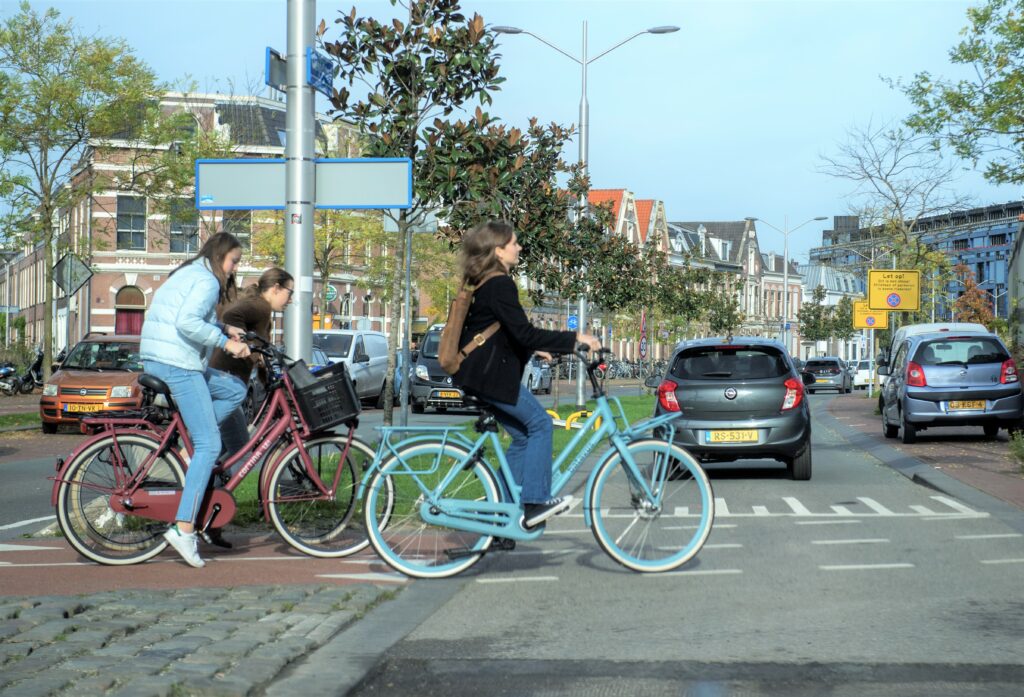Nowadays, cars are packed with sensors which they use to scan their surroundings. These smart cars are able to detect cars, cyclists, pedestrians, trees and other objects and can get from A to B safely. But those detections are not only useful for the vehicle itself, explains researcher Maria Salomons at TU Delft. “If the vehicle relays information regarding approaching cyclists, a traffic light can turn green even quicker.”
Project Connected vehicles and smart intersection control, June 2021-May 2023
Team Maria Salomons, Alphonse Vial and Andreas Hegyi
It will be some time before cars and other automatic vehicles start sharing their detections en masse with traffic lights. However, there is no doubt that it is technically possible, says Maria Salomons. This prompted her and her fellow researchers to investigate how to properly set up the sharing of ‘cyclist detections’ and how traffic control systems (which control traffic lights) can use that information as part of the project Connected vehicles and smart intersection control.

Dr. ir. A.M. (Maria) Salomons, researcher at TU Delft
For starters: how do you transfer vehicle information to a traffic control system?
“The technology for exchanging data is already available. We have recently discovered fast and reliable 5G. Soon every automatic car will be able to exchange large quantities of information with other connected vehicles as well as connected systems along the road quite easily via this reliable network. We have come a long way with these systems in the Netherlands: hundreds of intersections are already equipped with an intelligent traffic control system – or ITCS – which can both send and receive information. Not all of these ITCSs are suitable for 5G yet but it is only a matter of time. We have been investigating the best way for a smart car to share information regarding cyclists with the software in a traffic control system. That includes: how many cyclists are there, where are they precisely and at what speed are they going? The idea is that with this information, the control software in the ITCS will be able to anticipate bicycle traffic better and also give priority to groups of cyclists: traffic lights will turn green quicker.”
Why do you want to do that via these vehicles per se? Don’t we have loop sensors all over the cycle path for detecting cyclists?
“Yes, we do but cycle loop sensors actually only count passages. If two cyclists are riding next to each other, they will often be counted as one. What you are actually measuring is that something is ‘occupying’ the space of the loop as it is riding across it. Cameras are much better in that respect but just like loop sensors, they are quite pricey. Also, few bicycles are fitted with a tracking system yet which is why the monitoring of bicycle traffic in practice lags car traffic considerably. But once all those automatic vehicles start sharing their data, you will suddenly gain additional eyes free of charge. As the number of smart cars on the road is going to increase over the next few years, the picture of the situation on the roads will only get increasingly sharper.”
Why is the prioritisation of cyclists so important?
“Cyclists hate constantly having to slow down or stop at traffic lights. The information that an ITCS receives from connected automatic vehicles provides a better idea of bicycle traffic so that we can reduce the number of stops. That way, you make cycling a lot more attractive.”

How did you set up the study?
“In our study, we investigated possible ways of setting up the concept of ‘cyclist detection via automatic vehicles’. So rather than carry out field tests, we began with a microsimulation: the digital simulation of an intersection. In this simulation, we introduced a variety of situations with cyclists, car traffic and the numbers of automatic vehicles: the so-called penetration rate. We developed our idea in this digital environment.
“We ensured that all cyclist detections – location, direction of travel and speed of a bicycle – were monitored in our ‘cyclist monitoring system’. This system predicts the route of cyclists based on the data received and with that input, we then got the ITCS to control the priority of cyclists.
“It sounds simple but in fact, it was far from it. Different cars will detect the same cyclist from different angles – and in some cases, depending on the field of vision, they may not detect that cyclist at all. Not to mention the possibility of incorrect perceptions by sensors. Setting up the monitoring system so that a clear picture of the cyclists’ location and speed could be obtained from such diverse input proved quite a challenge.”
What results have you achieved so far?
“Using the information on predicted and actual routes taken by cyclists and a simple algorithm, we were able to effectively give priority to the cyclists in the microsimulation. We were able to reduce the number of stops and subsequent delay for cyclists considerably. Just for comparison: our simulations showed that without an auxiliary system, 90% of cyclists have to stop at a red light. When using a detection loop sensor in the cycle path, 80% of cyclists have to stop. And here’s the thing: with our solution, this drops to 60%. So using automatic vehicles as a ‘cyclist sensor’ definitely offers added value!
“However, using a simple priority algorithm resulted in a considerable delay for the car traffic. Better algorithms will enable us to strike a balance between helping out cyclists and keeping the delays for car traffic to a minimum. We are currently working on this next step. We are due to carry out an initial field test in the near future. I’m so looking forward to that!”
More information:
Paper on the study
